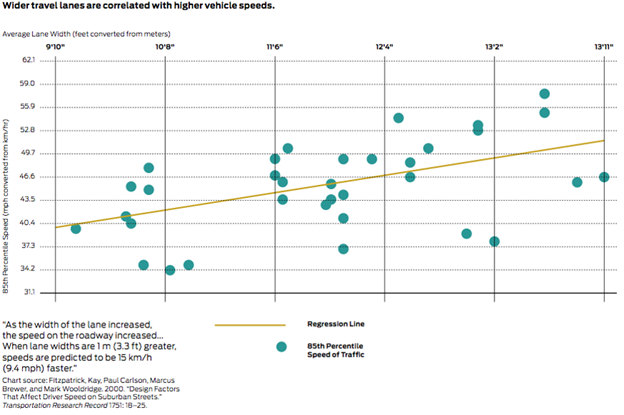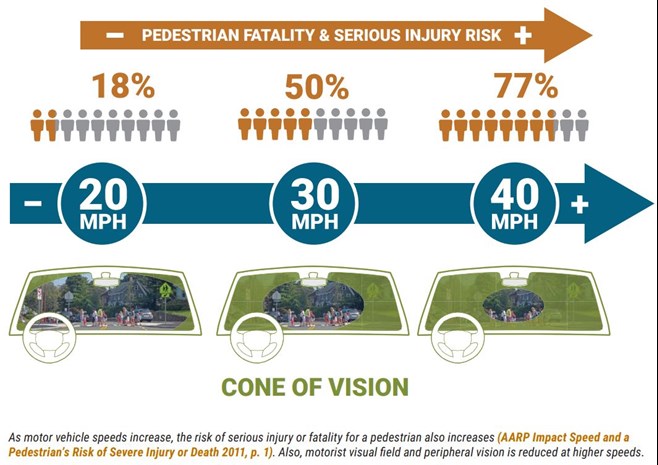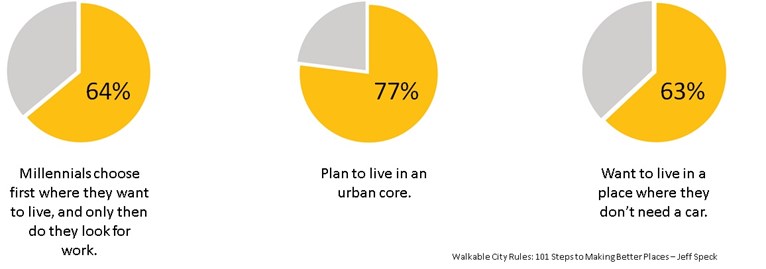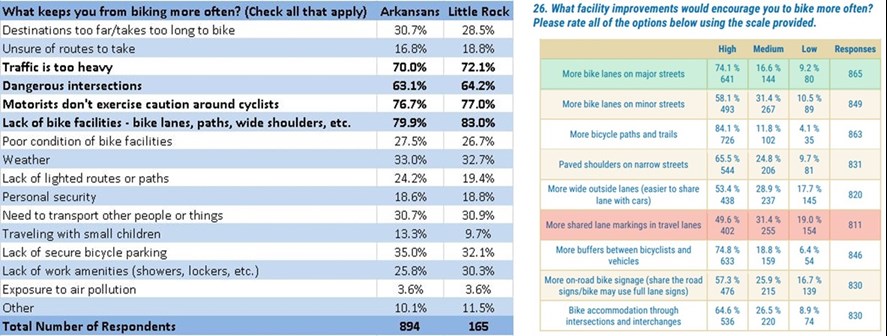Benefits
Making Kavanaugh Blvd. more comfortable to walk and bike would promote livability, community health, safety, and better connect Stifft Station, Hillcrest, and Heights neighborhoods to the city. It would also be more consistent US DOT/FHWA guidance for facility type and with the priorities stated in City of Little Rock Resolution, Ordinance, goals, agenda, policy statements, and Mission/Vision.
Traffic Calming
Narrowing traffic lanes calms traffic and creates safer and more welcoming conditions for all road users and the neighborhood (Fig. 1). Perhaps the most vital place to calm traffic is in the business district within which bike lanes will not be added. Given that the bike lanes can’t continue through the business district, the best way for this project to calm traffic is by continuing the bike lanes to Rose from the east and Hillcrest Square from the west. When the narrowed traffic lanes calm traffic leading up to the district on both sides, drivers will be less likely to speed up within the business district because of high pedestrian presence and other mixed use visual cues. Another traffic calming measure in the proposed project is the lateral shift (a.k.a. lane shift) between Pine and Cedar, with a 30 mph design speed, forcing cars to slow to navigate the shift.

Figure 1. Driving speed on residential streets is determined more by street design than posted speed limit. Wider lanes make drivers more comfortable driving faster, so they do (NACTO).
"The correlation between lane width and drivers speeds looks well thought out and documented. This alone is reason enough to implement the proposed bike lanes." - Butch J.
Pedestrian Safety
It may seem like this project would only benefit residents while they are riding a bike, however this project will increase pedestrian safety in several ways:
a) The project will calm traffic, which will both increase the visibility of pedestrians to motorists and will also improve outcomes of a car vs. pedestrian collision (Fig. 2).
b) This project will create a buffer between moving vehicles and sidewalks (Fig. 15). Some parts of Kavanaugh have no greenspace between the sidewalk and the street; the width of the curb is currently all that separates pedestrians on the sidewalk from moving traffic (Fig. 15, right).
c) This project will narrow the width of road that cars are moving from 42-52 ft. to ~20 ft. This shortens crosswalks and makes crossing the street safer and easier.
d) When sidewalks are in poor repair or blocked by trash cans or when a jogger seeks to run on asphalt vs. concrete, people in wheelchairs, parents with strollers, small children on scooters/bikes, and joggers are forced onto the street. Currently, that means forced into a vehicular traffic lane. Bike lanes will provide a space on the street where cars aren't.

Figure 2. As driver speed increases, the driver looks through a narrower and narrower cone, which can disproportionately affect visibility of bicyclists and pedestrians, who tend to be on a street's periphery (US DOT/FHWA).
"The crosswalks are blind to both walkers and drivers [due to parking]. Additionally, the sidewalks along Kavanaugh are heavily used by pedestrians (often with strollers, dogs, and kids); pedestrians must also use the street to pass because there isn't enough room on the sidewalk. Bike lanes would help both situations be safer for pedestrians in one of Little Rock's few (if only) walkable, complete neighborhoods." - Katie H.
Cyclist Safety
Despite all of Kavanaugh's safety challenges and user conflicts (see also Are Sharrows Good Enough?), it has relatively high bicycle traffic. This doesn't refute the mid- to high-stress nature of this corridor, but demonstrates its essential function as a local and regional bicycle connector. Kavanaugh is part of the City of Little Rock's adopted Master Bike Plan and also part of what will soon be over 50 miles of continuous bike facilities, but with only sharrows on a street that warrants better separation from vehicles, it is one of the weakest links in this chain. Creating better bike facilities on Kavanaugh will increase the utility of this entire +50 mile network.
Understand that people rarely drive their bikes on urban streets for recreation; it's much more comfortable to ride on the Arkansas River Trail for that (Table 2). People drive their bikes on the street to get somewhere: work, home, errand, the Arkansas River Trail, etc. Kavanaugh is critical to connecting the City's bike network.
"Observing that few people bike in a place without a good bike network is like saying that you don't need a bridge because nobody is swimming the river." Jeff Speck, Walkable City Rules (2018)
Community Cohesiveness
Giving Hillcrest residents the opportunity to safely and conveniently walk and bike creates face-to-face interactions and chance meetings that promote community.
"Having a bikeable city with dedicated infrastructure helps alleviate parking concerns, builds community and -- what i think is most important right now to Little Rock -- shows drivers that bikers are supposed to use the road. Little Rock drivers are hostile toward bikers on the road." - Guy C.
Increased Property Values
Bike lanes, especially in Hillcrest’s close proximity to the Arkansas River Trail, have the potential to increase property values in Hillcrest, especially on Kavanaugh.

Figure 3. Active transportation options make Little Rock a more attractive place, increasing the quality of our workforce and the incentive for businesses to invest here. Bike lanes on Kavanaugh, specifically, would make Hillcrest a more attractive neighborhood in Little Rock relative to others and increase property values.
Attracting and Retaining Talented Workforce
When choosing where to live, much of the young, creative class workforce wants transportation choice and livability (Fig. 3). If Little Rock wants to be a place that attracts business development, it must invest in the built environment a talented workforce seeks."Many cyclists have actually left Central Arkansas to go to NWA due to the bike friendly nature up in NWA's community. I would hate for professional cyclists, families and hobbyists to not feel safe using Kavanaugh on their bike. A designated lane helps ensure cyclists have the space they need to ride safely." - Jenny H.
Aging in Place
Hillcrest residents who depend on a car for most or all of their transportation needs may find it difficult to continue living in their same homes while maintaining mobility and independence in their old ages. Bike lanes on Kavanaugh would provide a car-free transportation option to the Hillcrest Business District.
Sustainable Transportation
Transportation is the largest source of Little Rock metro area’s carbon emissions; our metro area has the most Vehicle Miles Traveled out of 52 comparable communities. Bike lanes will encourage walking and biking for short errands supporting Hillcrest’s local economy over driving more miles to big box stores.
"This increases the safety of our community but also encourages the use of non-vehicle transportation. As we know this is great for our air quality and cuts down on the wear and tear of our roadways. This addition will not only keep people safe, it normalizes and promotes the inclusion of biking as a standard and economical mode of transportation." - Amanda A.
Reduce Hillcrest Business District Parking Demand
When Hillcrest residents can safely bike to the business district for errands, they will more often choose their bike over their car for health, to get fresh air, or because they know they’ll be able to find parking once they get to Hillcrest’s core. Buffered bike lanes will encourage biking to the Hillcrest Business District more than sharrows do (Tables 1 and 2.

Tables 1 and 2. When asked what keeps you from biking more often the four top answers, by far, have to do with a fear of being hit by a car (with Lack of Facilities #1). While Kavanaugh does have sharrows, these do not create separation between bikes and cars and are far less effective at encouraging people to bike than buffered bike lanes.
"...the hills, the curves, the speeds make traveling from Allsopp park to Markham a challenging experience, and one that only vehicular cyclists are likely to attempt." - David M.
Increase Retail Sales
Bike lanes increase retail sales. While this has been shown for many communities, one need look no farther than SoMa to see the transformational potential of bike lanes to a district. In Hillcrest, lack of convenient parking may dissuade Hillcrest residents or people outside of Hillcrest from shopping in the business district altogether. Cedar Hill is the Arkansas River Trail access point for Hillcrest, Stifft Station, and much of the Heights. Convenient bicycle access may encourage a different clientele, River Trail users, to stay, shop, and recover in Hillcrest.
Connections
Kavanaugh bike lanes would make bicycle commuting to/from downtown from Hillcrest and the Heights more feasible. Kavanaugh bike lanes would make access to the Arkansas River Trail from Stifft Station, Hillcrest, or the Heights more comfortable for all ages and abilities.
"I commute to work by bike many times a week, mostly through Hillcrest. Hillcrest is always the most stressful part of my route. Easier and safer connections from the Heights and Hillcrest to downtown for bikers will only benefit these neighborhoods and the City as a whole." - Steve C.
Driver Convenience
On the surface, this reconfiguration appears to serve only people who bike. However, in addition to the other business and neighborhood benefits discussed, drivers are benefitted specifically. Creating a separate space on the roadway for cyclists means that the travel lane is clearer and safer for motorists, especially when speed differentials are high when going uphill.
"I like the idea for the bike lanes on Kavanaugh getting a little redo. Right now, as a car driver, it stresses me out that the cyclists are so close. I'm afraid I might hit someone by accident. "- Katharine H.
Transit
Transit riders must get to a bus stop from their origin and get from a bus stop to their destination. This “last mile” problem is essential to make transit work and even more important in Little Rock where transit coverage is light. Kavanaugh is the Rock Region Metro Route #1; making Kavanaugh more bikeable increases transit access.
Safe Routes to Schools
Kavanaugh is an important Safe Routes to Schools corridor for Pulaski Heights Elementary, Pulaski Heights Middle School, and Mount Saint Mary’s Academy.
Safe Routes to Parks
Allsopp Park North, Allsopp Park South, War Memorial Park, Little Rock Zoo, six additional parks along Tri-Creek Greenway.




 Trash & Recycling
Trash & Recycling
 Online Payments
Online Payments
 City Documents
City Documents
 Parks
Parks
 Traffic Court
Traffic Court
 E-NEWS
E-NEWS
 EXPLORE
EXPLORE
 NEWS
NEWS
 TRANSLATE
TRANSLATE
